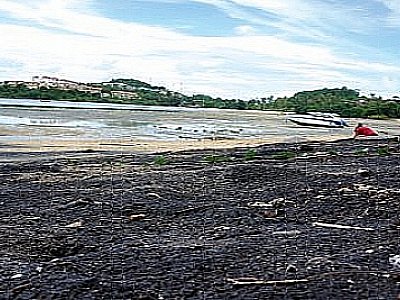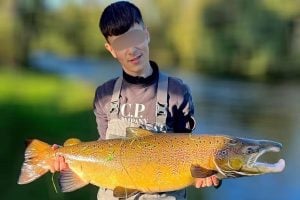The Riddle of Phuket’s Black Sands

SPECIAL REPORT
The Phuket Gazette investigates a reader’s inquiry into why much of the sand at Laem Panwa Beach is black – and why it sticks to anything metal. The Gazette‘s Chaiyot Yongcharoenchai, Stephen Fein and Chutharat Plerin report.
PHUKET: The west coast beaches of Phuket attract millions of tourists annually, but there is only one beach on the island that is truly magnetic: the black sands that line Makham Bay, off Cape Panwa in Wichit.
A concerned reader alerted the Gazette to the situation in April, after he took a few buckets of the black sand home thinking it would add a cool new look in his home aquarium.
Soon after buying a light-blue shrimp and placing it in the aquarium it turned dark brown. Later, when he accidentally dropped a magnetic algae scraper into the tank, he found it created chaos in the aquarium – the “gravel” leapt onto the magnets.
The reader, who initially thought the black sand was a wholly natural phenomenon like the basaltic black sand beaches in Hawaii, contacted the Gazette wondering what the strange black sand consisted of and, more importantly, whether it was as harmful to humans as it seemed to be the shrimp.
Noting that even images provided by Google Earth showed that the mystery sand was clearly visible offshore in black bands, he feared that it could be some kind of dangerous heavy metal that reacts in water and accumulates up the food chain to concentrations that can be toxic to humans – such as lead.
THE USUAL SUSPECTS
The Gazette contacted representatives of Thaisarco, which operates a large tin smelter at the north end of the bay, to see if they were responsible for the black sand or could shed any light on the subject.
Their representative noted that the black sediments dated back to the island’s tin-mining days, when the landscape in and around Ao Makham was extensively transformed. There are similar deposits at other beaches in Phuket, including some in Cherng Talay, they said.
Local residents in the area confirmed the age of the deposits, saying that they had been there for as long as anyone could remember – well before the Thaisarco smelter opened in 1963.
Phuket Provincial Industry Office Inspector Charan Nongsook concurred.
“The black beach at Cape Panwa is a unique feature of the area. It has nothing to do with Thaisarco. Decades ago there was an ore-processing operation in the area, with local residents panning for [tin] there as well. The small black pieces mixed with the sand are ore cinders,” he said.
Geologist Umpai Thongpinyochai, of the Phuket Office of Primary Industries and Mines, explained, “Since Phuket was extensively mined for tin in the past, there were many ‘placer deposits’ or secondary minerals, left in the area.
“These kind of secondary minerals were all originally mixed together with the stone when it was mined.”
When the stone was broken down by mechanical processes to extract the tin, the “placer deposits” were those unwanted elements separated out as sediments by gravity.
“When they mined for tin back then, they extracted the tin only and threw away whatever was left.
“The remainder, collectively called ‘ore cinder’, typically comprised many different kinds of ores,” she said.
STICKING POINT
Krit Promsorn, another expert at the Primary Industries and Mines Phuket office, examined a sample of the deposits provided by the Gazette and gave his explanation as to how they most likely ended up on the beach – and why they were magnetic.
“From a preliminary visual examination of the sample and the background of the Ao Makham area, I would say the black deposits mixed up with the sand are magnetite. This is a ferrimagnetic mineral with chemical formula Fe3O4. It is one of several iron oxides and a member of the spinel group,” he explained.
“After extracting the tin, they just dumped the magnetite because it did not have any economic value,” he explained.
“Back in those days, tin miners would take a boat called a ‘sledge’ just offshore and dig up deposits from beneath the sand. They kept only what they were looking for, dumping everything else overboard. Over time, these deposits could have migrated ashore from wave action.
“But from the look of this beach, I have a feeling they were not just swept ashore by currents or waves, but rather were dumped directly on the shoreline. Operations that conduct themselves like this would be illegal today. They would never be permitted because they could harm the environment,” Mr Krit said.
“The economy of Phuket back then didn’t rely on tourism like it does now, and there was no Thai Industrial Standards Institute to regulate the tin-mining industry. So what we are seeing now is a legacy from the past,” he added.
“No one can fix all the mistakes of the past. The best we can hope for is to mitigate the environmental impacts and ensure that such negligent business practices are never allowed to happen again,” he said.
CLEAN BILL
Ms Umpai said that despite their magnetic properties, the black ores of Ao Makham were most likely harmless to humans who come into normal contact with them.
“It doesn’t have any serious negative affects on the biosphere and isn’t toxic to humans. One ore that is potentially toxic to humans is Arsenopyrite, which [can oxidize to produce] arsenious acid,” she said.
“But what I have seen at the beach appears to be just magnetite. We could run a laboratory test to confirm whether or not there is any arsenopyrite ore mixed in with the sand, but I suspect the results would be negative.
“Arsenopyrite ore is yellow and smells strongly of hydrogen sulfide. We can easily spot it, even without scientific testing. But the ore found on the beach is black and shiny,” she said.
Madusop Rakharb, a 65-year-old retired resident of the area, agreed that the black sediments were harmless ore cinder. While few foreign tourists visited the beach, it is still sometimes used by local residents as a picnic spot, he said.
“We do not have any problems with the ore cinder on the beach. It is a natural thing in our area, the same as normal beach sand except for the color,” he said.
The Phuket Gazette would like to thank the reader, who asked not to be named, for bringing the issue of the black sands to our attention. Click here to see our related editorial column.
Latest Thailand News
Follow The Thaiger on Google News:


























